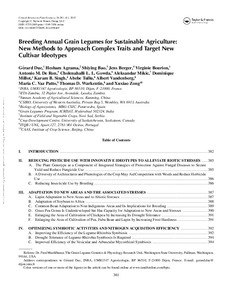| dc.contributor.author | Duc, G. |
| dc.contributor.author | Agrama, H. |
| dc.contributor.author | Bao, S. |
| dc.contributor.author | Berger, J. |
| dc.contributor.author | Bourion, V. |
| dc.contributor.author | Ron, A.M. de |
| dc.contributor.author | Gowda, C.L.L. |
| dc.contributor.author | Mikic, A. |
| dc.contributor.author | Millot, D. |
| dc.contributor.author | Singh, K.B. |
| dc.contributor.author | Tullu, A. |
| dc.contributor.author | Vandenberg, A. |
| dc.contributor.author | Vaz Patto, M.C. |
| dc.contributor.author | Warkentin, T.D. |
| dc.contributor.author | Zong, X. |
| dc.date.accessioned | 2019-12-04T10:57:22Z |
| dc.date.available | 2019-12-04T10:57:22Z |
| dc.date.issued | 2015 |
| dc.identifier.citation | Duc, G., Agrama, H., Bao, S., Berger, J., Bourion, V., De Ron, A. M.,Gowda, C.L.L., Mikic, A., Millot, D., Singh, K.B., Tullu, A., Vandenberg, A., Vaz Patto, M.C., Warkentin, T.D. and Zong, X. (2015). Breeding annual grain legumes for sustainable agriculture: New methods to approach complex traits and target new cultivar ideotypes. Critical Reviews in Plant Sciences, 34(1-3), 381-411. |
| dc.identifier.issn | 0735-2689 |
| dc.identifier.uri | https://hdl.handle.net/20.500.12478/716 |
| dc.description.abstract | Although yield and total biomass produced by annual legumes
remain major objectives for breeders, other issues such as
environment-friendly, resource use efficiency including symbiotic
performance, resilient production in the context of climate change,
adaptation to sustainable cropping systems (reducing leaching,
greenhouse gas emissions and pesticide residues), adaptation to di-
verse uses (seeds for feed, food, non-food, forage or green manure)
and finally new ecological services such as pollinator protection,
imply the need for definition of new ideotypes and development of
innovative genotypes to enhance their commercialization. Taken
as a whole, this means more complex and integrated objectives
for breeders. Several illustrations will be given of breeding such
complex traits for different annual legume species. Genetic diver-
sity for root development and for the ability to establish efficient
symbioses with rhizobia and mycorrhiza can contribute to better
resource management (N, P, water). Shoot architectures and phe-
nologies can contribute to yield and biotic constraint protection
(parasitic weeds, diseases or insects) reducing pesticide use. Vari-
able maturity periods and tolerance to biotic and abiotic stresses
are key features for the introduction of annual legumes to low
input cropping systems and for enlarging cultivated area. Adapta-
tion to intercropping requires adapted genotypes. Improved health
and nutritional value for humans are key objectives for developing
new markets. Modifying product composition often requires the
development of specific cultivars and sometimes the need to break
negative genetic correlations with yield. A holistic approach in
legume breeding is important for defining objectives with farmers,
processors and consumers. The cultivar structures are likely to be
more complex, combining genotypes, plant species and associated
symbionts. New tools to build and evaluate them are important if
legumes are to deliver their exciting potential in terms of agricul-
tural productivity and sustainability as well as for feed and food. |
| dc.format.extent | 381–411 |
| dc.language.iso | en |
| dc.subject | Breeding |
| dc.subject | Ecosystem Service |
| dc.subject | Grain Legumes |
| dc.subject | Foods |
| dc.subject | Forage |
| dc.title | Breeding annual grain legumes for sustainable agriculture: New methods to approach complex traits and target new cultivar ideotypes |
| dc.type | Journal Article |
| dc.description.version | Peer Review |
| cg.contributor.crp | Grain Legumes |
| cg.contributor.affiliation | International Institute of Tropical Agriculture |
| cg.contributor.affiliation | Yunnan Academy of Agricultural Sciences |
| cg.contributor.affiliation | University of Western Australia |
| cg.contributor.affiliation | International Crops Research Institute for the Semi-Arid Tropics |
| cg.contributor.affiliation | Institute of Field and Vegetable Crops, Serbia |
| cg.contributor.affiliation | University of Saskatchewan |
| cg.contributor.affiliation | Institute of Crop Science, China |
| cg.contributor.affiliation | Institut National de la Recherche Agronomique, France |
| cg.contributor.affiliation | Spanish National Research Council |
| cg.contributor.affiliation | Instituto de Tecnologia Química e Biológica |
| cg.coverage.region | Africa South Of Sahara |
| cg.coverage.country | Nigeria |
| cg.researchtheme | BIOTECH & PLANT BREEDING |
| cg.isijournal | ISI Journal |
| cg.authorship.types | CGIAR and advanced research institute |
| cg.iitasubject | Genetic Improvement |
| cg.iitasubject | Grain Legumes |
| cg.iitasubject | Plant Breeding |
| cg.journal | Critical Reviews in Plant Sciences , |
| cg.publicationplace | London, United Kingdom |
| cg.accessibilitystatus | Limited Access |
| local.dspaceid | 70335 |
| cg.targetaudience | General Public |
| cg.identifier.doi | https://dx.doi.org/10.1080/07352689.2014.898469 |

